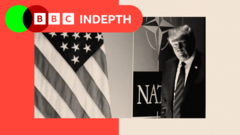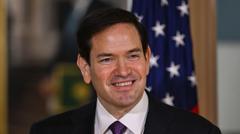As the U.S. administration blames China for the fentanyl crisis, Beijing emphasizes the issue's roots in American practices.
China Enhances Fentanyl Regulations Amid U.S. Trade Dispute

China Enhances Fentanyl Regulations Amid U.S. Trade Dispute
New controls on fentanyl precursors emerge as both nations address their escalating trade tension.
China has intensified its oversight of two precursor chemicals essential for manufacturing fentanyl, a response to increasing pressure from the United States over the opioid crisis. The Trump administration contends that Beijing has not exerted enough effort to prevent the powerful synthetic opioid from entering the U.S., where it continues to claim thousands of lives annually.
In a recent announcement, six Chinese government agencies declared that they would impose stricter regulations on 4-piperidone and 1-Boc-4-piperidone, both pivotal for fentanyl production. These changes—effective from July 20—reflect China's intent to collaborate with the United States on the crisis, according to Yun Sun, the director of the China program at the Stimson Center.
Following a meeting between China’s Minister of Public Security, Wang Xiaohong, and newly appointed U.S. Ambassador David Perdue, the announcement comes amid ongoing discussions to combat drug trafficking. The U.S. has accused Chinese manufacturers of supplying cartels with essential ingredients for fentanyl, which are subsequently smuggled into American borders. However, China maintains that the root of the crisis lies with the U.S., attributed to the misuse of prescription painkillers.
“We’ve repeatedly made it clear that fentanyl is the United States' problem, not China’s,” articulated Guo Jiakun, spokesperson for China’s Foreign Ministry, adding that the responsibility to resolve this matter rests solely on the U.S.
Despite the imposition of tariffs by the Trump administration amounting to 20 percent on Chinese imports connected to fentanyl, broader tariffs were substantially reduced in a recent trade truce between the two nations. Nonetheless, Chinese export restrictions on critical minerals have surfaced, creating tension in ongoing negotiations.
President Trump and China’s top leader, Xi Jinping, expressed willingness to revive trade discussions in a recent phone call. Prospects for an in-person meeting between the leaders depend on advancements in negotiations regarding trade and the ongoing fentanyl problem.
Wu Xinbo, dean of the Institute of International Studies at Fudan University, mentioned that a China-hosted meeting could be plausible, contingent on progress in resolving disputes. Another opportunity for dialogue might arise at the upcoming Asia-Pacific Economic Cooperation summit in Seoul later this year, where Mr. Xi is expected to attend. However, attendance confirmations from both leaders remain undisclosed.
In a recent announcement, six Chinese government agencies declared that they would impose stricter regulations on 4-piperidone and 1-Boc-4-piperidone, both pivotal for fentanyl production. These changes—effective from July 20—reflect China's intent to collaborate with the United States on the crisis, according to Yun Sun, the director of the China program at the Stimson Center.
Following a meeting between China’s Minister of Public Security, Wang Xiaohong, and newly appointed U.S. Ambassador David Perdue, the announcement comes amid ongoing discussions to combat drug trafficking. The U.S. has accused Chinese manufacturers of supplying cartels with essential ingredients for fentanyl, which are subsequently smuggled into American borders. However, China maintains that the root of the crisis lies with the U.S., attributed to the misuse of prescription painkillers.
“We’ve repeatedly made it clear that fentanyl is the United States' problem, not China’s,” articulated Guo Jiakun, spokesperson for China’s Foreign Ministry, adding that the responsibility to resolve this matter rests solely on the U.S.
Despite the imposition of tariffs by the Trump administration amounting to 20 percent on Chinese imports connected to fentanyl, broader tariffs were substantially reduced in a recent trade truce between the two nations. Nonetheless, Chinese export restrictions on critical minerals have surfaced, creating tension in ongoing negotiations.
President Trump and China’s top leader, Xi Jinping, expressed willingness to revive trade discussions in a recent phone call. Prospects for an in-person meeting between the leaders depend on advancements in negotiations regarding trade and the ongoing fentanyl problem.
Wu Xinbo, dean of the Institute of International Studies at Fudan University, mentioned that a China-hosted meeting could be plausible, contingent on progress in resolving disputes. Another opportunity for dialogue might arise at the upcoming Asia-Pacific Economic Cooperation summit in Seoul later this year, where Mr. Xi is expected to attend. However, attendance confirmations from both leaders remain undisclosed.






















